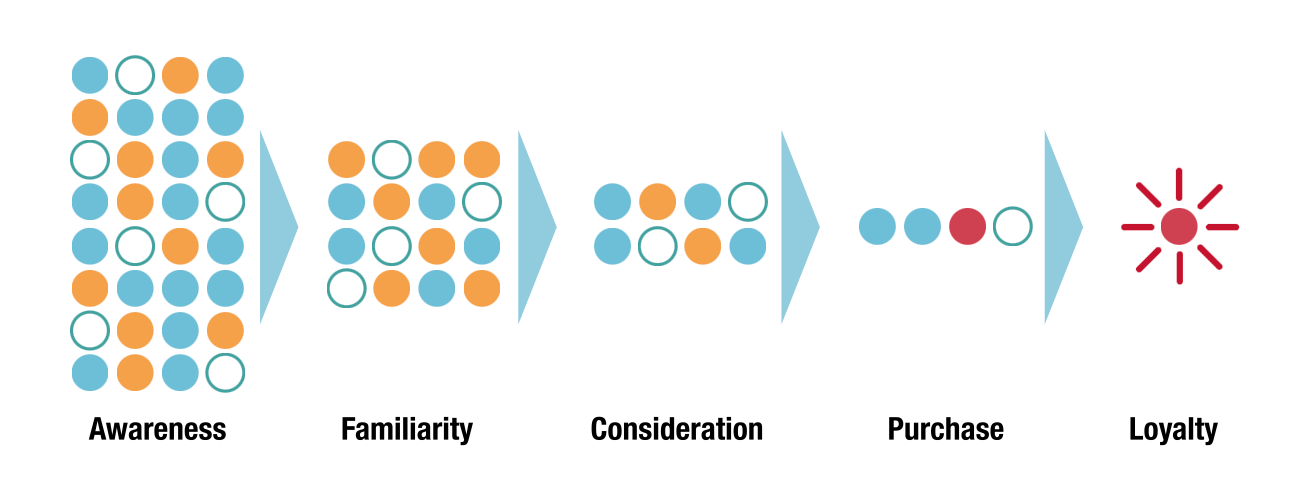
Was ist eine Customer Journey?
Die Customer Journey, oder auch Kundenerfahrungsreise, beschreibt den gesamten Weg, den ein (potenzieller) Kunde durchläuft: Vom ersten Moment, in dem er auf das Unternehmen aufmerksam wird, bis zum Kauf und darüber hinaus. Diese Reise soll durch das Unternehmen möglichst kundenzentriert gestaltet werden.
Die Customer Journey bezieht sich auf die verschiedenen Schnittstellen zwischen Unternehmen und Kunden. Sie beschreibt die Phasen, die eine Person durchläuft, bis sie ihr Ziel – den Erwerb eines Produkts oder einer Dienstleistung – erreicht und ihre Bedürfnisse erfüllt hat.
Obwohl Interessenten:innen und Leads erst ab dem Kauf als Kunden betrachtet werden, wird der Begriff Customer üblicherweise für die gesamte Reise verwendet. Bei McKinsey & Company umfasst die Customer Journey alle Interaktionen und Erfahrungen einer Person mit der Marke:
«Customer journeys are the complete set of interactions that a consumer has with a brand for any given task or decision.»
Customer Journey – ein Erfolgsrezept für zufriedene Kunden
Jeder Kunde durchläuft während der Kundenreise verschiedene Phasen. Je besser das Unternehmen auf die Kundenbedürfnisse ausgerichtet ist, desto mehr positive Erlebnisse bleiben den Interessenten und Interessentinnen auf dem Weg in Erinnerung und desto wahrscheinlicher ist es, dass sie sich für einen Kauf entscheiden und darüber hinaus dem Unternehmen treu bleiben.
Damit ist die Customer Journey ein zentrales Konzept in der Kundenzentrierung. Oder gar das Erfolgsrezept: Denn wie wird eine völlig fremde Person zur glücklichen Kundin – wenn nicht das Unternehmen die Kundenbedürfnisse ins Zentrum stellt und sämtliche Touchpoints auf die potenzielle Kundschaft ausrichtet?
Welche Phasen gehören zur Customer Journey?
Die Customer Journey besteht in der Regel aus mehreren Phasen. Grob wird zwischen Vorverkauf, Kauf und Nachkauf unterschieden. McKinsey stellt die Customer Decision in fünf Schritten dar:

- Awareness: In der ersten Phase erkennt der Kunde ein Problem oder ein Bedürfnis.
- Familiarity: In der darauffolgenden Phase versteht er, dass es möglicherweise eine Lösung für das Problem gibt, und macht sich mit dem entsprechenden Unternehmen vertraut.
- Consideration: In der Consideration-Phase recherchiert der Interessent / die Interessentin, berät sich oder lässt sich beraten und vergleicht Angebote.
- Purchase: Ist der Kunde überzeugt, fällt die Kaufentscheidung. Wichtig sind hier einfache und reibungslose Abläufe im Kaufvorgang, damit diese Phase aus Kundensicht angenehm gestaltet ist.
- Loyalty: In der Nachkaufphase können Kundinnen durch personalisierten Kundenservice, regelmässige Kommunikation oder spezielle Angebote und Aktionen weiterhin erreicht werden. So kann eine langfristige Kundenbeziehung aufgebaut werden.
Die Kundenreise entwickelt sich meistens nicht linear. Nebst unvorhersehbaren Abweichungen kann die Customer Journey je nach Anbieter und Entwicklung des Kundenverhaltens variieren. Wichtig ist, dass ein Unternehmen aktiv auf Veränderungen reagiert und regelmässig den Grad seiner Kundenzentriertheit reflektiert. Probeweise können sich Unternehmen die folgende Frage stellen: Wem bieten wir was, wann, wie und warum an?
Indem Unternehmen die Customer Journey evaluieren und verstehen, können sie Schwachstellen identifizieren, die Kundenerfahrung optimieren und dadurch ihren Erfolg steigern.
Wollen Sie mehr darüber erfahren, wie Sie die Kundenzentrierung Ihres Unternehmens messen und optimieren können? Kontaktieren Sie uns. Wir beraten Sie gerne persönlich.
Quellen:


